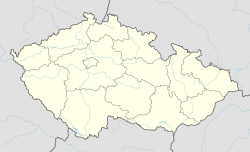Libouchec
| Libouchec | |||
|---|---|---|---|
| Municipality | |||
|
|||
| Coordinates: 50°45′45″N 14°2′17″E / 50.76250°N 14.03806°ECoordinates: 50°45′45″N 14°2′17″E / 50.76250°N 14.03806°E | |||
| Country |
|
||
| Region | Ústí nad Labem | ||
| District | Ústí nad Labem | ||
| Area | |||
| • Total | 28.01 km2 (10.81 sq mi) | ||
| Elevation | 336 m (1,102 ft) | ||
| Population (2007) | |||
| • Total | 1,869 | ||
| • Density | 67/km2 (170/sq mi) | ||
| Postal code | 403 33 to 403 35 | ||
| Website | http://www.libouchec.cz/ | ||
Libouchec (German: Königswald) is a village and municipality (obec) in Ústí nad Labem District in the Ústí nad Labem Region of the Czech Republic.
The municipality covers an area of 28.01 square kilometres (10.81 sq mi), and has a population of 1,869 (as at 31 December 2007).
Libouchec lies approximately 12 kilometres (7 mi) north of Ústí nad Labem and 80 km (50 mi) north of Prague.
Libouchec is situated in the valley of Jilovsky brook, which separates the Czech Central Mountains and the Elbe Sandstone Mountains.
Already in the 10th and 11th century were established two fortresses (in today's Jílové and in Libouchec). Later, in the 13th century, was established around this royal stronghold new village Libouchec. Its original name was Regis Silva (Königswald). But the first official mention was in a chronicle in 1169. The first settlers were Celts and Germanics, from the 5th century initially mainly Slavic peoples and from the late Middle Ages onwards mainly Germans.After World War II almost the entire population of the town was expropriated without compensation and expelled due to their German ethnicity. Libouchec was mainly resettled with Czechs, Slovaks and Roma.
There was a very important Salt trail through Libouchec. Salt was carrying from here to Děčín where it was embarked and sent to inland. There started an important production in manufacture in the end of feudalism (buttons, textile, primitive machines). The nobility from Bynov began in the 16th century with logging, mining of ore and silver. In the 19th century was its surroundings industrial region. There began the production of velvet, liqueurs, mustard and agricultural machines.
...
Wikipedia



